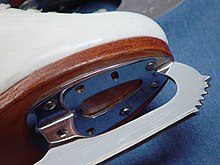Figure skating
sport and art performed with figure skates on ice
Figure skating is a sport in which individuals, duos, or groups perform on figure skates on ice. It was the first winter sport to be included in the Olympic Games, when it was contested at the 1908 Olympics in London. The four Olympic disciplines are men's singles, ladies' singles, pair skating, and ice dance. Non-Olympic disciplines include synchronized skating, Theater on Ice, and four skating.


Quotes
edit- But the Central Red Army Club had a long history of producing skating champions, and the coaches knew how to train a young child for future success. We did physical conditioning off the ice three times a week-abdominals, humping, leg exercises-and ballet training three days a week, which I loved. We learned how to stand, how to hold our heads, how to hold our hands and arms. Everything. There was a mirror the entire length of the army club rink where we skated, so we could keep an eye on our posture. And I was always the smallest one, boy or girl.
- Ekaterina Gordeeva, E. M. Swift, My Sergei: A Love Story, "Childhood", (1996)
- As a practical matter, my first question to Mr. Burroughs was, "Will I have clean ice for figures?" Clean ice meant that I would be able to replicate the competition experience by not being able to see the tracings laid down before me ina previous patch. Even after resurfacing, it was usually possible to see these tracings through the thin layer of new ice. Having these tracings was beneficial anda hindrance at the same time. If the tracings were good, we used those marks and followed them. But it almost felt like cheating. If they were bad, it distracted us. Either way, they prevented the development of one's own skills in creating circles on blank ice. I would get to competitition and my right-footed circles would be larger than my left-footed circles. Like most skaters, I didn't have the same control on my let side that I did on my right, so I developed the habit of making these circles too quickly.
- Dorothy Hamill, A Skating Life: My Story, ch. 5, “This Way to the Olympics”, (2007).
- Considering that fact about the Winter Olympics not coming to be until the 1920s, it's hardly surprising that skaters who peaked in their skills and abilities well ahead of the '20s often gravitated to either skating carnivals, or is some cases, the nightclub "tank ice" shows that were popular in big cities from 1912 until the start of Prohibition (when the traditional nightclubs closed). Not only were these events the primary source of income for so-called "professional" skaters, but the enthusiastic crowds they attracted were as close as most skaters of the day would come to tasting Olympic glory.
- Born in 1898 in Germany and performing on ice for audiences just ten years later, Charlotte quickly developed a reputation that allowed her to be described with three words: musical, graceful, and artistic. By 1910 she was finding success in Berlin with "[[w:ice ballets" - hybrids of pantomine and musical comedy played out on ice. And when ice ballets became cost prohibitive in Germany in the World War 1 era, she took up an offer to come to New York City, in 1915, with 20 other ballet company members. Performing as part of the musical revue Hip Hop Hooray at New York's newly reopened Hippodrome, Charlotte and company captivated audiences to the tune of 425 performances in just 300 days.
The appeal of these early performances was as hard to miss as Charlotte herself. Clad in white boots and barely knee-length skirts (both were unheard of at the time for female skaters), her ability to catch the eye with her physical appearance even superseded her ability to land the one-and-a-half rotation axel jump. She is, in fact, credited as the first woman to include axels in her programs.- Kelli Lawrence, Skating on Air: The Broadcast History of an Olympic Marquee Sport, “From London 1908 to Hollywood 1948: Figure Skating Before Television", (Jan 10, 2014), p.9
- I'd love to have Bob Fishman, our director, calling the camera shots as he did back then, selecting the pictures that you see in your living room. I'd love to once more experience the camaraderie of 50 men and women - our figure skating unit - united in an effort to show case such a special event.
- Verne Lundquist in Kelli Lawrence, Skating on Air: The Broadcast History of an Olympic Marquee Sport, "Introduction", (Jan 10, 2014), p. 3
- It's my view that people like skating because it is a visual picture of freedom...it's like a soul set free. People have told me that they enjoyed it because the beauty calmed them; the skaters kind of looked like birds in flight. I think that kind of freedom is built into our spirit. And I think some great TV directors understand that, and have a keen eye how to capture that, and make people want to set aside time to sit down and watch skating.
- Janet Lynn: as qtd in Kelli Lawrence, Skating on Air: The Broadcast History of an Olympic Marquee Sport, “From London 1908 to Hollywood 1948: Figure Skating Before Television", (Jan 10, 2014), p. 7
- Figure skating was all of it! Skating was an incredibly great sport which involved all the aspects and abilities that a great athlete needs to have-strength, timing, and all that stuff. It was an amazingly competitive sport as well. And it was theater! It was dance! And the "actors" took on roles as they skated! So for me, it became a home.... I became fascinated with it.
- Doug Wilson: as qtd in Kelli Lawrence, Skating on Air: The Broadcast History of an Olympic Marquee Sport, "Barely a Small Screen Sport: Skating Through TV's Golden Age", (Jan 10, 2014), p. 17.